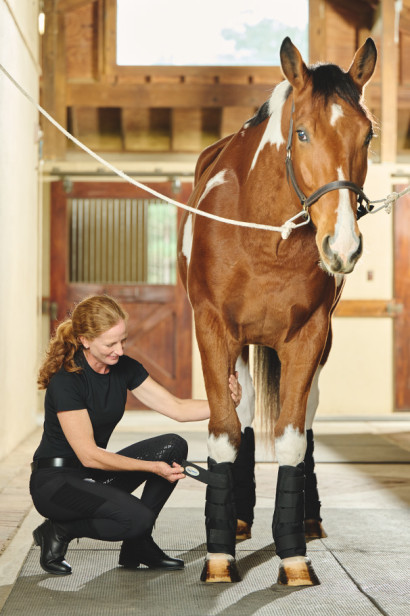Discover the Impressive Benefits of Equine Therapy for Emotional Recovery
Discover the Impressive Benefits of Equine Therapy for Emotional Recovery
Blog Article
Reviewing the Performance of Laser Treatment in Horse Treatment for Injury Recovery
The analysis of laser treatment's efficiency in equine injury recovery hinges on several elements, consisting of recuperation time, discomfort mitigation, and tissue regeneration. Veterinarians frequently observe superior outcomes with laser treatment compared to standard techniques, placing it as a crucial element in equine treatment.
Comprehending Laser Treatment
Laser treatment has actually become a pivotal device in vet medicine, specifically in the therapy of equine conditions. Known for its non-invasive nature and efficacy, laser therapy involves the application of details wavelengths of light to boost cells repair service and lower inflammation. This restorative method is increasingly favored for its ability to increase the recovery procedure in steeds struggling with a variety of bone and joint injuries and chronic problems.
The main system behind laser treatment is its ability to improve cellular features. Furthermore, laser therapy advertises vasodilation, improving blood flow and oxygen shipment to broken tissues, therefore accelerating recovery.
In equine medicine, laser treatment is particularly valuable for problems such as tendonitis, osteo arthritis, and wound healing. The method is admired for its pain-relieving residential or commercial properties, permitting equines to restore flexibility and feature much more rapidly. Veterinarians likewise appreciate its very little adverse effects compared to other treatment methods, making it a trustworthy and risk-free alternative for equine care.

Exactly How Laser Therapy Functions

Upon absorption, these photons cause a series of biochemical changes, enhancing mitochondrial feature and leading to raised adenosine triphosphate (ATP) manufacturing. This increase in ATP increases cellular metabolic rate, advertising cells repair service and regeneration. Furthermore, laser treatment modulates inflammatory responses by influencing cytokine degrees and lowering oxidative tension, thus minimizing discomfort and swelling.
An additional substantial aspect of laser therapy is its role in improving microcirculation. The treatment promotes vasodilation, improving blood circulation and oxygen delivery to damaged tissues (Equine Therapy). This helps with the removal of cellular debris and supports the spreading of fibroblasts and collagen synthesis, critical for injury get redirected here healing
Professional Evidence
The efficacy of laser treatment in equine therapy has actually been validated through numerous medical researches, showcasing its therapeutic possible across a range of conditions. A research performed by Turner et al. (2012) showed that horses treated with low-level laser treatment (LLLT) for tendon injuries displayed sped up healing contrasted to those receiving conventional treatments.
Likewise, research by Johnson and colleagues (2015) concentrated on equine muscular tissue injuries, exposing that laser therapy substantially sped up muscle fiber regrowth and minimized muscular tissue rigidity. These findings were substantiated by histological evaluations showing better muscle tissue company. Professional analyses have revealed that laser treatment can minimize persistent problems such as osteoarthritis. A research study by Smith et al. (2018) reported that steeds with osteoarthritic joints experienced noteworthy pain relief and enhanced array of activity adhering to a regimen of laser treatment sessions.
Vet Insights

Veterinarians also value the flexibility of laser therapy. She directs out that laser therapy can be tailored to the certain needs of each equine, making sure optimum results.
Moreover, veterinarians value the ability to incorporate laser treatment with other therapy modalities. This multimodal approach can boost overall treatment effectiveness, offering a thorough remedy for equine rehab. Such endorsements from seasoned experts emphasize the growing approval and application of laser therapy in equine medicine.
Practical Factors To Consider
A crucial element of applying laser treatment in equine therapy involves understanding the practical considerations that ensure its efficiency and safety. Firstly, it is crucial to choose the proper laser device, as numerous types differ in wavelength, power, look at here and infiltration deepness. Equine Therapy. Veterinarians should be fluent in these specifications to tailor treatment procedures effectively per injury kind
Furthermore, the frequency and duration of laser treatment sessions need mindful preparation to make the most of healing you can check here benefits while decreasing any prospective adverse impacts. Regular tracking of the steed's reaction to treatment can direct necessary adjustments in the treatment regimen. Developing a risk-free and controlled atmosphere during treatments is also vital to prevent unintentional direct exposure to laser exhausts, which could hurt both the horse and the handler.
Educating and accreditation of personnel administering laser treatment are paramount to guarantee proper method and to copyright safety standards. In addition, maintaining accurate records of each session, including laser settings and observed outcomes, is vital for examining the total efficiency of the treatment and for making data-driven choices.
Conclusion
Laser treatment has actually become an effective modality in equine injury rehabilitation, using substantial advantages in healing time, pain relief, and cells recovery. Professional studies underscore significant improvements in problems such as tendonitis and osteo arthritis, attributed to enhanced mobile feature and enhanced ATP production. Veterinarian monitorings affirm these searchings for, highlighting remarkable results contrasted to traditional treatments. For optimum results, constant tracking and customized treatment protocols continue to be essential in leveraging the full capacity of laser therapy in equine treatment.
Report this page